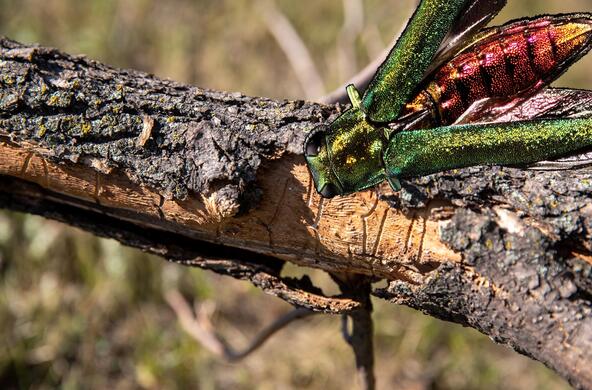When asked ‘what’s the greatest threat facing U.S. trees,’ common answers are climate change and development. Few realize imported insects and diseases top the list. Emerald ash borer, Asian longhorned beetle, hemlock woolly adelgid – these are just a handful of the small imported pests causing big problems.
Cary Institute forest ecologist Gary Lovett recently led the most comprehensive synthesis to date on forest pests, covering ecological and economic impacts and evaluating policy solutions. Collaborators included experts from the Science Policy Exchange, Harvard Forest, the USDA Forest Service, The Nature Conservancy, Dartmouth College, McGill University, and Michigan State.
The main message of the study: efforts to prevent new forest pests are not keeping pace with escalating trade and must be strengthened if we are to slow the loss of our nation’s trees. Lovett explains, “Imported forest pests are the most pressing and underappreciated forest health issue in the U.S. today. We need to act now to strengthen prevention if we are going to protect billions of valuable trees in communities and forests across the nation.”
Each year, imported forest pests cause more than $2 billion in damages. Most arrive as stowaways in international cargo. Some 25 million shipping containers enter the U.S. annually; thousands have forest pests lurking among their goods. Major pathways of introductions include solid wood packing material, such as pallets and crates, and live plants bound for the nursery trade.
The problem is widespread; imported forest pests are present in every state.
New York, Massachusetts, Ohio, Michigan, California, Idaho, North Carolina and Florida are among the hardest hit. Sixty-three percent of U.S. forestlands – or 825 million acres – are at risk of increased damage from established forest pests. They are the only threat that can decimate entire tree species within decades, and have already eliminated American chestnuts from our forests and American elms from our streets.
Urban and suburban trees are the costliest forest pest casualties. Tree removal and replanting is expensive, and loss of trees from streets, yards, and parks affects property values, cooling, flooding, air quality, green infrastructure, and aesthetics.
With partners at the Science Policy Exchange, Lovett is leading an initiative to promote the policy measures needed to prevent new forest pests from arriving and establishing. Lovett notes, “Taking action to prevent new forest pests will alleviate the economic burden borne disproportionately by homeowners and municipalities while safeguarding our trees and the valuable benefits they provide.”
Tree-SMART Trade focuses on advancing five high-priority actions identified by research, among them adopting alternatives to solid wood packaging and ending or limiting imports of live trees and shrubs that share a genus or species with plants native to the U.S. Learn more by visiting www.caryinstitute.org/tree-smart-trade.






